
French postcard by Editions Lafayette in the Nos artistes dans leurs expressions series, no. 6. Photo: Comoedia.
Peggy Vere aka Peggy Vère (?-?) was a British music-hall artist, dancer and singer, as well as a stage and screen actress. She debuted at the Parisian music-hall Concert Mayol and at the Théâtre des Variétés, then moved on to the Ambassadeurs and Casino de Paris in 1920. Between 1920 and 1940 she mostly performed at the Concert Mayol again. She was active in spreading the Lambeth Walk in France. De Vere made her film debut in 1919 in the propgandistic drama Dans les ténèbres (Théo Bergerat, 1919). In 1923 she acted in La porteuse de pain (René Le Somptier, 1923), one of the many adaptations of Xavier de Montepin's popular novel, scripted by Germaine Dulac, and with Suzanne Desprès in the lead. In the comedy Ma tante d'Honfleur (Robert Saidreau, 1923) she played Albertine, opposite Jane Loury as the title character. In the early sound era she also played in two films, Le roi du camembert (Antoine Mourre, 1931), in which she had a lead as Miss Peggy Wood opposite Louis Rollin as the title character, and a supporting part in La dernière nuit (Jacques de Casembroot, 1933), starring Florelle.

French postcard by Edit. Art de Comoedia in the Nos artistes dans leurs expressions series, no. 7. Photo: Comoedia.
Marie-Caroline Laparcerie, bettter known as Cora Laparcerie (1875-1951), was an actress, poetess and French theatre director.
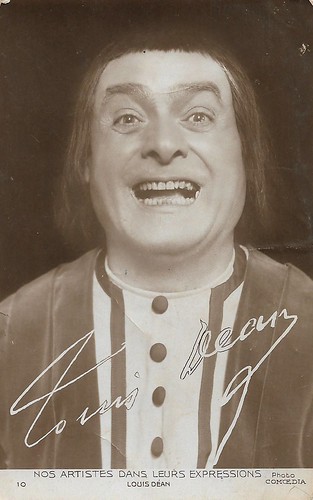
French postcard by Edit. Art de Comoedia in the Nos artistes dans leurs expressions series, no. 10. Photo: Comoedia.
Louis Déan was a French stage actor, about whom nothing much is known. In 1880 he acted as the British reporter Harry Blount in the play Michel Strogoff at the Théâtre du Chatelet, with Armand Bernard in the lead. Déan acted at the premiere of George Feydeau's play Le Dindon in 1896 in Paris. Felix Hugenet played the lead at the time. By the 1900s, Déan acted at the Théâtre de Porte Saint-Martin. Apparently, Déan often played the comical sidekick, as in 1915 the French reporter Jolivet in Michel Strogoff, Passepartout in La Tour du monde en 80 jours, and Coquillet in Les Exploits d'une petite Française. By the 1920s he acted the Théâtre du Chatelet again. On this card he probably must have been in his sixties. NB Déan should not be confused with the American silent film actor Louis Dean.

French postcard by Edit. Art de Comoedia in the Nos artistes dans leurs expressions series, no. 13. Photo: Comoedia.
Abel Tarride (1865-1951) was a French stage and screen actor and playwright, best known for his interpretation of Commissioner Maigret in the film Le Chien jaune (1932), made by his son Jean Tarride. Tarride first had a rich career as stage actor and playwright between the 1880s and the 1920s. He was also manager of the Théâtre de la Renaissance in Paris after Sarah Bernhardt and Lucien Guitry, and also managed the Théâtre des Bouffes-Parisiens and the Théâtre des Mathurins, and he was involved in the Théâtre national de l'Odéon and the Théâtre de l'Apollo. With the actress Marthe Regnier he had two sons, the future director Jean Tarride and the future actor Jacques Tarride. In the 1930s Tarride had an active career in French sound cinema, after incidental screen performances in the 1920s.

French postcard by Edit. Art de Comoedia in the Nos artistes dans leurs expressions series, no. 19. Photo: Comoedia.
French actor and painter Robert Hasti (1880-1956) appeared in a dozen French films of the 1910s and 1930s.
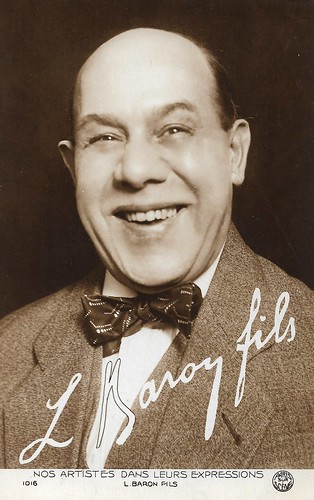
French postcard by Paris sur scene in the Nos artistes dans leurs expressions series, no. 1016.
Louis Bouchêne, known as Louis Baron, fils or just Baron fils (1870-1939), was an actor and singer, who performed in many operettas and comédie-musicales, and also in some 50 films between 1910 et 1938. He was the son of Louis Baron often associated with the works of Jacques Offenbach.

French postcard by Paris sur scene in the Nos artistes dans leurs expressions series, no. 1017.
On basis of the French site Gallica, we can conclude that Pelissier (?-?) must have had his breakthrough around 1910 at the Eldorado, soon rivaling Dranem, Boucot, and Tramel. He was between the mid-1910s and the mid-1920s a highly popular Parisian music-hall comedian, performing at e.g. La Cigale, Olympia, Moulin-Rouge, Concert Mayol, and above all the Eldorado and the Ambassadeurs. During WWI, he did charity performances in the provinces, as in Arcachon in 1917. In 1932 he played what may have been his only film role, as the 'patron' in the French early sound film Son plus bel exploit (André Chotin, 1932). a musical comedy starring Mireille.
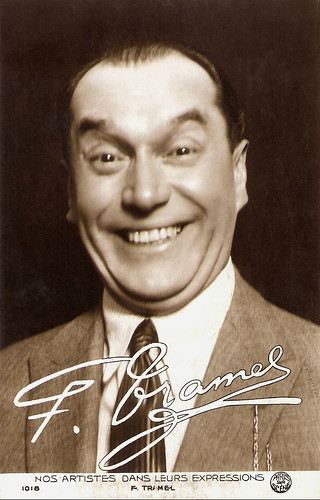
French postcard by Paris sur scene in the Nos artistes dans leurs expressions series, no. 1018. Photo: Comoedia.
Félicien Tramel (1880-1948) or just Tramel was a French singer and actor. Tramel made more than 30 78’s at Odeon with such hits as 'T'en fais pas Bouboule' (Do not worry Bouboule) and 'Y me faut mon patelin' (I miss my hometown). Between 1911 and 1947 he played in dozens of films. In a series of silent and sound comedies, Tramel starred as the character Alfred Bicard or Le Bouif.
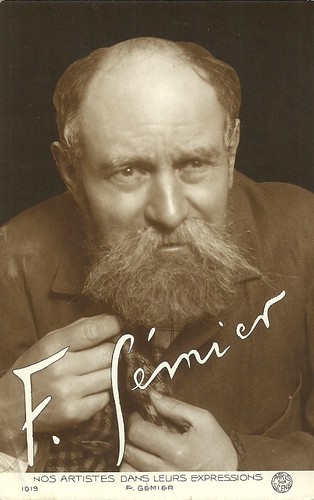
French postcard by Paris sur scene in the Nos artistes dans leurs expressions series, no. 1019.
Firmin Gémier (1869-1933) was actor, director and theatre manager at the French stage, promotor of the Théâtre Populaire, and founder of the first Théâtre National Populaire (Paris, 1920). He also acted in French silent and sound cinema of the 1910s to the 1930s.

French postcard by Paris sur scene in the Nos artistes dans leurs expressions series, no. 1020. Charles Le Bargy in the play 'Le Duel' by Lavedan.
Charles Le Bargy (1858-1936) was already a famous stage actor in his time, performing at the Comedie Française when he debuted in the film as the perfidious king Henry III in L'Assassinat du Duc de Guise (1908).
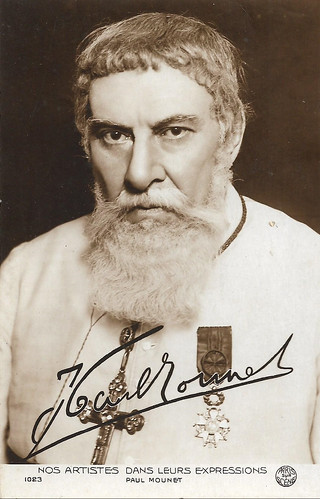
French postcard by Paris sur scene in the Nos artistes dans leurs expressions series, no. 1023. Paul Mounet in Par la vérité/By the truth (Maurice de Féraudy, Gaston Leprieur, 1917).
Paul Mounet (1847–1922), born Jean-Paul Sully, was a French actor of the Comédie Française, who also acted in various Film d'art films around 1910.

French postcard by Paris sur scene in the Nos artistes dans leurs expressions series, no. 1024.
Georges Biscot (1886-1945) was a popular French music-hall and revue singer and actor. He also had a career in French silent and sound cinema.
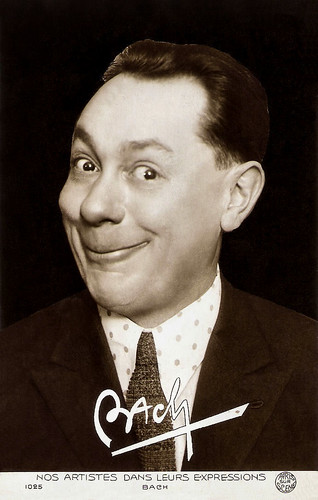
French postcard by Paris sur scene in the Nos artistes dans leurs expressions series, no. 1025.
Bach (1882-1953) was a popular French actor, singer, and music hall performer. During the 1930s, he was the king of the Comique Troupier (coarse comedy).

French postcard by Paris sur scene in the Nos artistes dans leurs expressions series, no. 1041.
Georgé (1880-1969), born Ernest Georgé, was a French stage and screen actor, who played in 16 films between 1920 and 1948. He made his debut in the fantasy film Asmodée à Paris (1921). The next year he had the title role in Le Noël du père Lathuile (Pierre Colombier, 1922). After a few minor parts, he had a major role as the priest in Colombier's comedy Paris en cinq jours (Pierre Colombier, 1926), starring Dolly Davis and Nicolas Rimsky. In the early sound era he did almost one film per year between 1930 and 1937, including the comedy Conduisez-moi, Madame (Herbert Selpin, 1932) with Jeanne Boitel, and La châtelaine du Liban (Jean Epstein, 1934), but from the mid-1930s his parts became small, uncredited ones. In 1947-1948 Georgé did his last three film parts, including Mademoiselle s'amuse (Jean Boyer 1948) with Ray Ventura and Gisèle Pascal.

French postcard by Paris sur scene in the Nos artistes dans leurs expressions series, no. 1042.
Albert Lambert (1865-1941), aka Albert Lambert fils, was a French stage and screen actor, who was for a long time part of the Comédie-Française. He also played in several early French Film d’Art films, first of all in L'Assassinat du Duc de Guise (1908).

French postcard by Paris sur scene in the Nos artistes dans leurs expressions series, no. 1044.
Georges Colin (1880-1945) was a French actor, who appeared in nearly 40 silent and sound films between 1909 and 1945.
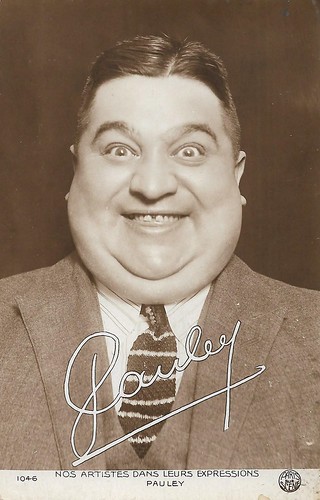
French postcard by Paris sur scene in the Nos artistes dans leurs expressions series, no. 1046.
Pauley or Paul Pauley (1886-1938) was a French actor and singer, who knew a prolific career in French cinema of the 1930s.

French postcard by Paris sur scene in the Nos artistes dans leurs expressions series, no. 1047.
Marcel Lévesque (1877-1962) was a French actor and scriptwriter who excelled in French silent and sound comedies. He also played memorable parts in the crime serials by Louis Feuillade and in Jean Renoir’s Le Crime de M. Lange (1936).

French postcard by Paris sur scene in the Nos artistes dans leurs expressions series, no. 1049.
Gabriel Signoret aka Signoret (1878 - 1937) was a French actor and director who played in some 85 films, mostly silent ones.

French postcard by Edit. Art de Comoedia in the Nos artistes dans leurs expressions series, no. 1051. Photo: Comoedia.
Maurice Chevalier (1988-1972) was a French actor, singer and entertainer. His trademark was a casual straw hat, which he always wore on stage with a cane and a tuxedo.

French postcard by Edit. Art de Comoedia in the Nos artistes dans leurs expressions series, no. 1053. Photo: Comoedia.
Fortugé (1887-1923) was a French artist, who was a popular Music-hall and Café Concert singer before and after World War I. He recorded several of his comic songs for Pathé Frères. His early death made an end to his successful career.
Sources:
No comments:
Post a Comment